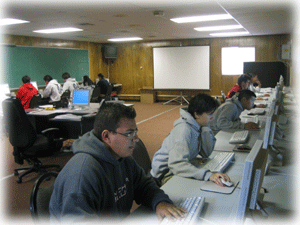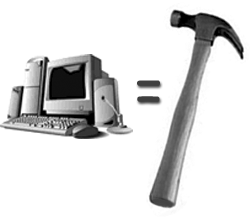
Using the "Integrated Approach" to Teach Technology Introduction What is the best way to give High School students the technological skills that they will need in order to be successful in the future? This is a question that High School computer Teachers and Technology Coordinators have been trying to answer ever since the first computers were put into classrooms. But the answer to this question has been rather elusive. A new approach to teaching technology, which merges content instruction with technology instruction, could prove to be the best way to teach students what they will need to know about computer applications. The Traditional Approach The most common way that computer skills have been taught in High Schools is by instructing students in "separate" computer science classes (Picciano, 2002). This approach basically puts computer science into its own category, just like math or english. The students in computer science classes generally learn about the history of computers, and then they learn a variety of computer related skills. In this approach, the focus is on the specific technological skills involved with using computers. The "Integrated Approach" The integrated approach to teaching technology combines content area instruction with computer skills instruction. Rather than learning computer skills in their computer class, the students are given projects which involve technology in all of their classes. This approach is aimed at showing students that technology is a tool that they can use to increase their knowledge, improve their productivity, and to complete complex tasks (Eisenburg & Johnson, 2002). Why the "Integrated Approach" Works One reason this approach is so effective, is because students learn to apply their technological skills in a variety of settings. A student who can transfer a skill from one class to another will probably be able to retain that skill, and use it in the future. Using the "integrated approach" also increases the amount of time that students actually spend using technology. In the traditional approach, students would most likely take one semester, or one year of computer science. Students who attend a school that has technology integrated into the curriculum, will work with computers for their entire stay at the school. Studies have also shown that using technology in content area classes improves student achievement and the rate at which students learn (Schacter, 1999). Implementation Hurdles There are several factors which have prevented this approach from being implemented in many schools. The first, is that this approach requires a large amount of technological resources. If all of the Teachers on campus are going to use technology in their lessons, they will all need access to the technology. This approach also requires a highly trained faculty. The faculty will not only have to come up with lessons that integrate technology into their content area, but they will also have to teach the students how to use the technology. Conclusion The way that technology is being used in colleges and in the workplace is changing rapidly. High Schools need to adjust, and give their students the skills that they will need in order to be successful. As stated by Dr. Kathleen Fulton, of the University of Maryland, "today's students must learn to become "information navigators", finding their way through print, graphic, electronic, and visual media to discover and interpret relevant information. They must become critical thinkers and analyzers using technology to access, interpret, and evaluate the quality and appropriateness of the information they have discovered." Although implementing the "integrated approach" may seem rather daunting to teachers, there are many resources available to help them along. Many instructors and organizations have developed web sites which provide stimulating lesson plans (which integrate technology) for every discipline. An example lesson plan can be seen in this month's tutorials section. References Eisenburg, M.B., & Johnson, D. (2002) Learning and Teaching Information Technology Computer Skills in Context. Syracuse, NY: Syracuse University. ERIC Clearinghouse on Information and Technology. Available online: http://ericit.org/digests/EDO-IR-2002-04.shtml Fulton, K. (1997). Learning in the digital age: Insights into the issues. The skills students need for technological fluency. Santa Monica, CA: Milken Family Foundation. Available online: http://www.mff.org/pubs/ME164.pdf Picciano, Anthony G. (2002). Educational Leadership and Planning for Technology (3rd Ed.). New Jersey: Merrill Prentice Hall. Schacter, John. (1999). The Impact of Education Technology on Student Achievement: What the Most Current Research Has to Say. Santa Monica, CA: Milken Family Foundation. Available online: http://www.mff.org/pubs/ME161.pdf |

